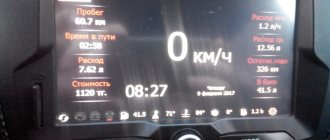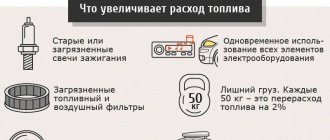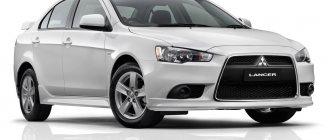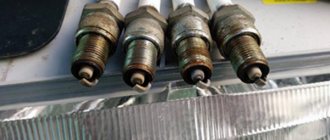The cost of owning a car is made up of many factors, one of the main ones being fuel consumption. Let's figure out what gas consumption for the Lada Niva (Chevrolet) is indicated in the technical specifications. And how different it is from real owner reviews.
Specifications
Chevrolet Niva has been produced since 2002. The model is based on a VAZ-2123 engine, volume 1.7. There is an independent 2-link front suspension. At the rear there is a continuous bridge. Since this is an SUV, it comes with all-wheel drive. The transfer case distributes torque between the front and rear axles in equal proportions - 50/50.
Increased cross-country ability is facilitated by a lowering row, the presence of an inter-axle locking mechanism and well-executed body geometry. The car moves comfortably both in off-road conditions and on the highway in the city.
The modification on a VAZ engine is characterized by the following parameters:
- Gas engine;
- piston stroke – 80 mm;
- number of valves – 8.
The average gasoline consumption is 10 liters per 100 km. Feature - in urban highway conditions there is an increase in consumption to 13.2–14.2 liters.
Fuel consumption of Niva Chevrolet per 100 km according to the passport
According to the documentation, the Niva Chevrolet has the following gasoline consumption per 100 km:
- city (road, highway) – 14.1 l;
- highway - 8.8 l;
- the average is 10.2 liters.
This characteristic is valid for an engine with the Euro-5 environmental standard, volume 1.7. For modification 1.8 with a similar European standard, a decrease in consumption is noted .
Gasoline is consumed in the following quantities:
- city - 12.7 l;
- highway - 10.4 l;
- the average is 8 liters.
If the owner notices an increase in consumption or is dissatisfied with the performance of the devices, then you need to find out the reason, then contact the service center.
What affects fuel consumption
Fuel consumption increases and decreases depending on driving style. This parameter is also affected by the selected road (rough terrain, city highway, highway). Consumption indicators increase in proportion to the weight of the machine. For the Chevrolet Niva, this figure is 1.5 tons with a compact body. In the restyled model, consumption was reduced to 1.4 liters.
Dynamic characteristics also affect fuel consumption. The injector helps save gasoline.
Chevrolet Niva 1.7 real reviews on average fuel consumption: gasoline
In fact, we already had an answer to the first question in one of our previous materials: no, despite the foreign emblem, a domestic SUV will not be more problem-free. Almost all components and assemblies of the Niva require regular attention and repair, and also, preferably, replacement with imported, more reliable analogues, which, alas, are sometimes simply not produced.
As in the case of Patriot, we focus on original products, official service regulations, the average cost of repair work in Moscow and St. Petersburg, as well as the cost of alternative spare parts on popular federal online stores.
Routine work
Chevrolet Niva is equipped with the well-known VAZ 1.7 series 2123 engine, which the manufacturer itself recommends servicing every 15,000 km, which, of course, is a lot for a used car in our conditions. It is better to immediately focus on reducing the interval to 10,000 km, especially if the car is often used for its intended purpose, that is, off-road.
Actually, first of all, immediately after purchase you should go for a comprehensive maintenance in order to change at least all consumables and operating fluids.
Even at a dealer, the procedure is inexpensive: engine and gearbox oil, fuel, air and oil filters, as well as spark plugs and full diagnostics and additional lubrication work will cost about 6,500 rubles, of which half the price is the cost of transmission oil.
It's worth closing the issue with the brakes too, fortunately it costs pennies. Original pads will cost 500 rubles for the front ones and 700 rubles for the rear drums. It’s interesting that alternative parts are offered by many famous manufacturers, including Brembo, whose pads will cost 1,500-2,000 rubles for a pair of front ones. The work will cost about 2000 rubles.
If the front brake discs also need to be replaced, then you should immediately look in the direction of non-original ones, since Bosch parts cost almost the same as original ones - about 1,200 rubles. Replacing them will cost about 1,500 rubles.
In total, basic routine maintenance will cost about 11,400 rubles if you replace all the brake pads and front discs with good non-original ones.
An interesting nuance: the official supplier of Chevrolet Niva parts offers to replace the rear drum brakes with more efficient disc brakes, even releasing a special conversion kit, which includes the entire assembly assembly. This one costs 16,400 rubles.
Repair
Like the UAZ, the main problem of the Shniva in the engine compartment is the weak timing drive mechanism. The chain runs about 100,000 km, the other mechanisms of the unit are even less. After partially disassembling the engine, you should immediately change the hydraulic compensators, as well as the oil pump and cylinder head gasket, which will still begin to “ask questions” with good mileage on the odometer.
The original timing kit with chain, sprockets and other necessary items costs 2,700 rubles. There are no good imported non-original ones, but it’s worth looking separately for an Isai automatic chain tensioner, which is noticeably more reliable than the original “Pilot”. The asking price is about 1000 rubles. The cost of replacement work along with valve adjustment will cost from 3,500 to 5,000 rubles, depending on the service.
A set of hydraulic compensators will cost from 2000 to 2500 rubles, depending on the manufacturer’s brand. We recommend not saving and installing imported ones from the global concern Ina. Replacement work will cost about 1,500 rubles. An oil pump, depending on the manufacturer, costs from 1,470 (original) to 2,000 rubles for analogues. Removal and installation - about 2500 rubles.
The most expensive job is replacing the cylinder head gasket set. The work will cost about 5,000 rubles, and the original set will cost about 1,800 rubles. Separately, a cylinder head gasket costs 250 rubles. Total for engine repair with work and spare parts: 16,450 rubles and plus about 7,000 rubles if necessary to change the cylinder head gaskets.
As for other problems, the cooling system bothers the Chevrolet Niva more than anything else. A leaking radiator, cracked tanks and weak pipes are a standard picture for tire drivers.
The original radiator costs 2,500 rubles, another 1,000 rubles will be spent on a set of pipes, and a new tank will cost a measly 220 rubles. Removal and installation will cost about 2000 rubles. The most expensive thing in the Shnivy cooling system is the double electric fan, which costs about 4,000 rubles and replacement work will cost almost the same.
It happens that a generator breaks down, replacing which will cost about 1,300 rubles, but the spare part itself is not cheap - about 5,000 rubles for the original or a decent analogue.
One of the consumables on the Shniva is the clutch, which, due to the weakness of the engine, constantly has to be burned during regular off-road use. The good news is that this mechanism is offered by global concerns, for example, Sachs or Veleo, although they are more expensive than domestic ones - from 5,000 to 6,000 rubles and the same amount for labor. The flywheel will cost another 2,500 rubles. In total, repairs for attachments and clutch will cost about 22,000 rubles.
As for the repair of the gearbox and transfer case, complex work, depending on the complexity, starts from 3000-4000 rubles for each mechanism. A completely new transfer case assembly comes in two modifications and costs either 17,000 or 27,000 rubles.
Another consumable for the Chevrolet Niva is wheel bearings, which do not tolerate water and last up to 15,000 km. Relatives cost pennies - about 400 rubles apiece. There are a lot of non-originals on the market, including world premium brands like SNR, which cost three times more. Some craftsmen select from commercial foreign cars like Iveco. Ball joints are also in the same price range.
Replacing the bearings will cost around 2,500 rubles, another 1,500 rubles will be spent on replacing the upper and lower ball bearings.
Shock absorbers cost 1,000 rubles apiece, and springs cost the same. The range for suspension arms is wider - up to 5,500 rubles. Replacing the rack assembly in a circle will cost about 7,000 rubles.
A fairly common problem on Shnivys is the replacement of drives and cardan shafts, especially the rear one. The cost of the part is about 5,500 rubles for a regular one and up to 7,000 rubles for a reinforced one, fortunately, the replacement cost is low - up to 1,000 rubles. You can even get by with a repair kit for 2,500 rubles. The crosspiece will cost about 1000 rubles. Each of the two front-wheel drives will cost another 4,500 rubles, and replacing one will cost about 2,000 rubles.
The total cost for repairing the transmission and chassis together with spare parts is about 32,600 rubles.
Conclusion
A comprehensive repair of a Chevrolet Niva, which will require the restoration of almost every component, will ultimately cost approximately 82,450 rubles. This is one and a half times cheaper than the cost of a comparable technical restoration of a UAZ Patriot, not to mention foreign competitors.
Actually, the lion's share of spare parts for the Shniva cost pennies compared to foreign cars, as well as their replacement. Even a major overhaul of a VAZ-2123 engine is unlikely to cost more than 25,000 rubles. The problem, as with the UAZ, is that many elements do not have good imported analogues, as a result of which either short-lived domestic parts have to be installed again, or “collective farming” has to be done.
Fuel consumption per 100 km Chevrolet Niva
Fuel consumption depends on many factors, such as driving style, operating conditions, engine wear, as well as other components and assemblies. Also, fuel consumption will be different due to different modifications of the installed power plants.
Let's consider the consumption under various operating modes on the Chevrolet Niva model. We will summarize all official data in a table with characteristics.
This model began production in 1998 and remains popular to this day:
- Chevrolet Niva (Generation 1 – 1998-2009; Generation 1 Restyling – 2009-present).
Along the highway
In practice, the highway driving mode for the Chevrolet Niva is the most economical driving option. This is also reflected in the passport characteristics declared by the manufacturer for this car.
But it is worth considering that fuel consumption according to the passport will differ from consumption in real conditions. Factory tests create ideal conditions and maintain optimal engine speed and rpm.
In the city
Driving around the city in a Chevrolet Niva is the most expensive mode in terms of fuel consumption. And real data may differ very much from the reference data set by the manufacturer.
Driving a car with sudden accelerations, frequent idle times at traffic lights, or in hours-long traffic jams do not contribute to fuel economy. As, indeed, are frequent trips over short distances made during the day.
If you exclude these factors, and also stick to a calm ride with smooth acceleration and braking. It is quite possible to meet the figures stated by the manufacturer, shown in the table below.
Medium (mixed cycle)
The average fuel consumption of the Chevrolet Niva implies driving a car in urban and suburban cycles. This is what people pay attention to when choosing a vehicle, as well as when taking into account expenses.
But the mixed cycle, like those given above, in real conditions may differ from the reference ones indicated by the manufacturer. Therefore, you should not rely on them fully.
Usually, experienced drivers, in order to get more realistic figures, advise adding 10-15% to the consumption indicated in the passport specifications.
Ways to save fuel
Chevrolet Niva lifting
Ways to save fuel
If you don't know how to reduce fuel consumption, below we suggest you familiarize yourself with a number of useful tips.
To reduce the gasoline consumption of a Chevrolet 100 km, try to maintain a speed of 90-100 kilometers per hour on the highway, no more. Operate the vehicle without sudden acceleration and instantaneous gear changes in the transmission. Constantly checking tire pressure can help reduce fuel consumption on a Chevrolet Niva. The optimal value is from 2.1 to 2.2 atmospheres. Install gas equipment
On the one hand, the equipment will not lead to fuel savings, but at the same time you will have to pay at least one and a half times less when refueling. On a Chevrolet Niva, as in any other vehicle, it is important to monitor the technical condition of the power unit. If at least one wire breaks through to ground, the engine dynamics will be poor.
Accordingly, consumption will increase both in the city and on the highway. Monitor the condition of the brake system. In practice, we often encounter situations where the brake cylinder begins to jam, thereby creating additional resistance. Ultimately, more fuel will be needed to maintain speed. The first alarm bell is a situation in which the brake system is very noisy, which is not typical for its usual state. Use air conditioning only when necessary. If the equipment includes a climate system, remember that its maintenance also consumes fuel. Accordingly, its proper use allows you to benefit.
LPG consumption
Installing gas equipment allows you to save a lot of money. Of course, gas consumption increases by 10-20%.
You should not trust the installers and hope that fuel consumption will remain at the same level. However, the increased consumption is offset by half the price of propane.
As a result, the cost of 100 km is reduced by 30-40%.
And the less economical your engine is, the more profitable it is to install gas equipment on it.
But we must not forget about the disadvantages of HBO:
- Additional costs for installation and maintenance of gas equipment.
- Reducing the usable volume of the trunk.
- Slight increase in vehicle weight.
As for mileage, the situation is ambiguous. A Chevrolet Niva will travel more on a full tank of gasoline than on a propane tank. But when refueling both types of fuel, you will get an additional 300 km until the next refueling.
Fuel consumption according to the passport and real
In accordance with the data on the passport, the vehicle demonstrates the following consumption indicators:
- when moving in the city - 10.8 liters;
- when driving on good roads on the highway in fifth gear - 8.6 liters at a speed of 90 kilometers per hour;
- when driving on the highway in fifth gear at a speed of 120 kilometers per hour, it is 11 liters.
Considering that at the end of 2015 the manufacturer switched to the production of power units adapted to the requirements of the Euro-5 standard, the indicators have changed. In the city, consumption is 14 liters, on the highway - 8.8 liters.
Interesting fact: despite the fact that the power of the power unit does not increase, gasoline consumption in new engines increases. The figures published above are presented by the manufacturer itself.
Now let's find out what fuel consumption the Chevrolet Niva actually has. If we analyze driver reviews, we can note that the difference between official and actual indicators is approximately five percent, no more. Accordingly, the actual consumption is quite close to the theoretical one. Of course, the volume of fuel combustion is affected by the period of summer and winter operation, where in the latter case you have to spend more gasoline on warming up. The intensity of the set of revolutions also affects.
Fuel consumption indicators
Gasoline consumption of this car ranges from 9 liters per 100 kilometers to 15.
Fuel consumption on the Chevrolet Niva in the city is 9 liters, on the highway - 11, in mixed mode 10.6 liters. But, as real owners of these cars say, fuel use is approximately 14 - 15 liters, it does not decrease, depending on the route, or the fluctuations are insignificant. Most of the gasoline consumption on the Niva 212300 comes from speed and driving habits. Despite all this, it is worth noting several huge advantages:
- high cross-country ability of an SUV;
- four-wheel drive;
- favorable pricing policy;
- quickly develops speed.
It is almost impossible to get a steel horse with all-wheel drive at this price, because prices for them start at the same point where prices for Chevrolets already end.
The question of the profitability of a car is always very acute, because not everyone can afford such costs for fuel or an expensive car. Therefore, the developers made a rather smart move by creating a budget option that is accessible to everyone. Of course, no company has yet managed to create the ideal car, but the price of this model fully corresponds to the quality.
Why does Chevy Niva consume more fuel?
Chevrolet Niva transfer case
The technical characteristics declared by the manufacturer do not quite correspond to the real ones. This applies not only to the Chevrolet Niva, but to any car.
The engine efficiency indicated in the official documentation is achievable only with a fully functional car on a good road with a calm driving style.
In this case, high-quality gasoline should be used and there should even be no headwind. Therefore, actual consumption is always higher than stated.
Even with ideal technical condition, the turned on air conditioner and aggressive driving style can add from 1 to 3-4 liters per 100 kilometers.
In winter, fuel consumption increases by 10-20% depending on the mileage. If you warm up the car for 10 minutes before driving a couple of kilometers, consumption can increase to 20 liters.
The following factors also affect the efficiency of the machine:
- Condition of the road surface. On broken asphalt, country roads, mud, snow or sand, the car needs more fuel.
- Condition of the engine, ignition and fuel system. Weak compression, clogged injector and other problems worsen engine efficiency.
- Incorrect wheel alignment angles, insufficient tire pressure. These factors increase rolling resistance, resulting in more fuel consumption.
Increased gasoline consumption also occurs when the cooling system malfunctions.
What is the actual consumption in the city and on the highway?
If you fully load the trunk or add a trailer, the consumption will increase to 2 liters per 100 km (taking into account that there is a driver and 1 passenger in the cabin).
Low dynamics appear if you reduce gasoline consumption. In this case, acceleration to “hundredth” will take 19 seconds. The maximum speed will be 140 km/h.
Fuel consumption will be more economical if you change driving modes. On the highway it’s about 10 liters, while quiet city driving will require 12-13. If you choose mixed modes, you can achieve figures of 11 l/100 km. Feature: in this case, oil consumption increases.
Factors affecting gasoline consumption
Every car owner cares about how much fuel his car consumes. In recent years, the race for economy and environmental friendliness has led to the emergence of a large number of cars with a really low “appetite”
Therefore, the figure of 6 liters per 100 km has long been no longer the subject of dreams, and 10 liters per “hundred” has become a psychologically important mark, consumption above which raises natural questions.
For Niva cars, consumption from 11 to 14 liters is considered quite normal, anything after 6-8 liters for front-wheel drive seems like a big waste. But you need to understand that the Niva is a full-fledged all-wheel drive and has high cross-country ability. But sometimes consumption exceeds acceptable standards - there can be many reasons for this.
For example, many engines based on a fuel injection system reduce their efficiency when used incorrectly, and this leads to increased consumption. Here are the main reasons why the engine burns fuel more actively:
- Low quality of gasoline itself and, as a result, malfunction of fuel filters.
- Fuel system contamination.
- Reduced compression in the engine.
- Significant wear of piston rings, pistons and cylinder block.
- Incorrect injector setting.
It is also worth highlighting the impact of air temperature, weather conditions and driving style on fuel costs. Sharp braking and acceleration lead to increased wastage of gasoline, and in winter, consumption can increase significantly, up to two times. This can be caused by low tire pressure in the cold and icy roads, which causes the wheels to grind at the start. Weather conditions also cause harm - blizzards and snowfalls, as a result of which the driver reduces speed and burns more fuel.
Fuel consumption
One of the most discussed topics among car owners is: what is the fuel consumption of the Chevrolet Niva? Let's figure it out. Consumption depends on many parameters, both on the characteristics of the car itself and on its operating conditions. Each specific car will always have its own, but there are fuel consumption standards set by the manufacturer. They are presented below, per 100 km.
Consumption of Chevrolet Niva 1.7 l Euro-2
- urban mode - 10.8 l
- highway consumption (5th gear, speed 90 km/h – 8.6 l
- highway consumption (5th gear, speed 120 km/h) – 11.6 l
Consumption of Chevrolet Niva 1.7 l Euro-5
- urban mode - 14.1 l
- highway consumption – 8.8 l
- average consumption – 10.2 l
Interestingly, the updated engine with the Euro-5 environmental standard has increased fuel consumption, but its power has remained unchanged.
Consumption of Chevrolet Niva 1.8 l
- urban mode - 12.7 l
- highway consumption – 10.4 l
- average consumption – 8 l
Technical side
So, the engine capacity of the Chevrolet Niva is only 1.7 liters, which indicates the low power of this model.
For an SUV of this class, this is quite enough, but you shouldn’t expect that its cross-country ability will be maximum in all weather conditions.
The design of this car is constantly being improved in the Italian workshop. The latest innovations were made quite recently; the car acquired new stylish rear-view mirrors, a bumper and a new grille. The model itself has large shapes and reaches almost four meters in length.
| Engine | Consumption (highway) | Consumption (city) | Consumption (mixed cycle) |
| Gasoline 1.7 | 8.6 l/100 km | 10.8 l/100 km | 9.7 l/100 km |
Increased fuel consumption on a Chevrolet Niva
The reality is that fuel consumption specifications are difficult to achieve. This is repeatedly confirmed by reviews. This situation is typical for all cars.
Reasons for data discrepancy:
- A fully functional machine is required;
- the road must be of ideal quality;
- presence of a smooth driving style;
- refueling with ideal quality gasoline;
- absence of head or side wind during measurements.
The weather factor also affects consumption. In winter, consumption increases by an average of 15%. Heating the motor increases consumption by another 10%, and when moving a short distance up to 20%. The same applies to driving for a short time with pre-warming.
How to reduce gasoline consumption?
There is unlikely to be a noticeable effect:
- From the use of “chemistry” (additives);
- From installing all kinds of “magnets”, etc.;
- Switching to “synthetics” (for example, 5W40) is a radical method, but not recommended;
- From the transition to AI-92, “liter consumption” increases slightly, consumption in rubles decreases.
To improve efficiency, you need to properly configure the transmission. People usually talk about balancing cardans, but know that imbalance can only occur as a result of deformation. There is no need to pay money for an almost useless procedure. However, let the owner make the final choice.
Balancing and correct installation of the RC
Everything is clear with shaft balancing, but other elements are usually not thought about.
Transfer case and two shafts
Make sure you meet the following requirements:
- The transfer case (RK) is installed so that the axis of the gearbox shaft and the primary axis of the RK meet at a point coinciding with the center of the CV joint (see drawing). Also, the steering wheel must be centered: each secondary shaft must be parallel to the bottom and directed strictly along the body.
- The crosspieces should turn easily, and, moreover, with the same force!
- Avoid play in splines, crosspieces and secondary shaft bearings.
The tighter the crosspiece rotates, the more the steering wheel can deviate on its “pillows”. This results in noticeable energy losses.
The crosspieces are located inside the anthers
Subtleties of diagnosis
By looking at the noise spectrum, you can find out what exactly is making noise. Let the rotation speed be N. Then:
- Only one of the crosses can produce a sound with a frequency of 2N;
- The secondary shaft of the RK will make noise with frequency N.
Common problem
Often the knock sensor on the 2123 engine fails. When installing it, it is “tightened” - the tightening torque should be 18 N*m.
Replacing the sensor
You just need to take it and replace the DD. Suitable options:
- 21120-3855020-00, -01, -02, -03;
- Fenox SD10100O7;
- BOSCH 0 261 231 046.
There will be two problems:
- The DD on the VAZ-2123 is accessible only from under the bottom (remove the lower panels);
- The ECM does not recognize the new sensor immediately, but after 20-30 km of “break-in”. Like this.
We wish you success.
Modifications
Chevrolet Niva (212300 - 55) first rolled off the production line back in 2002 and immediately gained popularity among drivers thanks to its good cross-country ability, powerful engine, reliability and low maintenance costs.
In its entire history, the car has experienced only one restyling in 2009 a modern appearance.
Niva Chevrolet 1.7 l
The heart of the Chevy Niva is the VAZ-2123 four-cylinder gasoline engine , developed on the basis of the VAZ-21214 injector back in the 90s of the last century.
Technical characteristics VAZ-2123 engine :
- volume - 1.7 liters
- power - 80 hp
- torque - 127.5 Nm (at 4000 rpm)
- maximum speed - 140 km/h
- Acceleration time to 100 km - 19 seconds
The engine was updated and improved several times, was modified and transferred by designers from the Euro-2 environmental standard to modern Euro-5 standards.
Since the end of 2015, all cars have been produced only with a Euro-5 class engine.
Niva Chevrolet 1.8 l
FAM-1 (VAZ-21236) was produced from 2006 to 2008. 1.8- liter Opel Z18XE .
Its technical data was superior to the VAZ engine:
- volume - 1.8 liters
- power - 122 hp
- torque - 167 Nm (at 3800 rpm)
- maximum speed - 165 km/h
- acceleration time to 100 km - 12 sec
The cost of the Chevy Niva in this configuration was much higher, so it was not in great demand, and in less than two years it was withdrawn from the market. However, such fields still travel safely on the roads of the country.
Screen, camera, socket
Generally speaking, Niva came from Togliatti to test the multimedia systems of domestic all-wheel drive vehicles. Yes, yes, it has a color screen and accompanying electronics. You will find a detailed report in the August issue of Za Rulem magazine. But as a person who, due to his age, is inclined to be skeptical about newfangled toys, I will share my impressions.
The main thing is that they didn’t skimp on the screen and rear view camera: everything works fully. But there are also very interesting little things. Multimedia was integrated into the old interior, and the forced decision turned out to be successful. Imagine placing a monitor in the center console. If you place it high, there will be important buttons at the bottom. If you give the top row to the controls, the screen shifted to the gear lever will lose its meaning altogether. In Niva it was placed to the right of the visor of the instrument cluster. It turned out well - both the buttons are in the right place and the screen. The multimedia control unit fits into the single-din hole for the radio. Also successful. Moreover, the system is available not only to owners of new Nivas: the factory workers promise to negotiate with dealers and ensure the installation of multimedia on any Nivas produced after 2015.
The multimedia system screen is successfully integrated into the interior.
The multimedia system screen is successfully integrated into the interior.
Music screen. System features - tracks are displayed in alphabetical order, regardless of the initial division into folders. |
The menu is intuitive. The user will quickly understand all the functions of the system. |
Another one
An important feature is the ability to turn off the screen (but not the system) in one click.
To do this, just click on the large right “twist” on the control unit. Very comfortable at night. Let's say they turned off the screen so as not to distract. You perceive navigation system commands only by ear. I needed a card - I pointed it with my finger, looked and turned it off again.
I was pleased with the system and its intuitive controls. I figured it out on the fly - I was in a hurry to get the test. So, the instructions were never needed. And there was no need to take much attention from the road—peripheral vision was enough to launch certain functions.
The multimedia control unit is located in place of the radio. Its USB connector is live, regardless of the position of the key in the ignition switch. |
The USB connector in the tray between the front seats is de-energized when the ignition is turned off. |
Navigation screen. Navitel is installed here. Works correctly. |
Projection from the rear view camera. Parking is convenient, the towbar does not block the view. |
The rear view camera itself is located in the rear bumper above the license plate. |
And finally, charging gadgets. The question is fundamental. Nowadays there is a fashion to turn off the power to all sockets and USB connectors when the ignition is turned off. Like, I went to the store, you can’t leave your phone in the car. But the Niva is an SUV and is used for long stays in nature. There are no sockets in the forest - you only need to recharge gadgets from a car battery. And it’s much more convenient to do this when the outlet is always powered. That is, it is possible to charge when the car is on the security alarm and the key is in the owner’s pocket. In this regard, Niva was made correctly. The introduction of multimedia did not affect the reasonable power supply of outlets. The one between the front seats is de-energized when the ignition is turned off, and the one on the control unit in the center console is always powered.
How not to reduce fuel consumption
It is not recommended to reduce consumption and consumption on your own unless you have the appropriate knowledge and experience . Also, there is no need to make radical changes (switching from gasoline to gas) when this is not clearly necessary.
Make technical replacements or changes in design - here all actions must be coordinated with specialists in the workshop or service station. They will also tell you how much fuel savings will be when choosing one version or another. Making changes to the firmware yourself can cause harm or reduce performance slightly.
Owner reviews
Owner reviews will help you decide whether changes should be made to make each kilometer cheaper.
Stanislav (Nizhny Novgorod): “The car has a 1.7 liter engine according to the technical specifications. Today I am using the updated 2021 model. Overall I can say that I am happy with the car. The mileage is 13,500 km, so the first maintenance was successfully completed. If you do not turn on the heating and air conditioning in urban conditions, then, according to my observations, it takes about 8-9 liters per 100 km. The previous model had a significantly higher figure – about 12-13 liters.”
Fuel consumption for a Chevrolet Niva with an Opel 1.8 engine
In 2006, AvtoVAZ began producing the Chevy Niva FAM-1 with a 1.8-liter Z18XE 122 hp engine. With. produced by Opel, this internal combustion engine was installed in tandem with a manual transmission. But in 2008, production of this modification was curtailed; in total, about 1,000 cars were produced in Togliatti.
In terms of fuel consumption per 100 km of run in this modification of the car, the following passport data are indicated:
- in the city - 12.7 l;
- city-highway (combined cycle) - 10.0 l;
- on the highway - 8.4 liters.
If you compare the RT on a 1.8 Z18XE SUV with a 1.7 VAZ-2123, it turns out that on the highway gasoline is consumed equally by different modifications of the car, and in the city a car with an Opel-like engine is even a little more economical.
In terms of dynamics, the 1.8 internal combustion engine outperforms the VAZ power unit; after all, the cylinder volume is larger, and Opel’s injection system and electronic control are better thought out. But the “native” Chevrolet Niva engine is quieter, and at low loads the VAZ-2123 outperforms the “foreigner”. According to reviews from car owners, the actual consumption of a car with a Z18XE is less than with a 1.7 liter, but 122 liters. With. still not enough for this SUV.
Fuel consumption aspect
The fuel aspect of expenses is the most important, because these are the expenses that the car requires every day: frequent oil changes, refueling with gasoline, etc. Gasoline consumption at idle Chevrolet Niva is slightly less than on conventional models, but this is not a big advantage.
Basically, on the forums it is recommended to calculate consumption per car in such a way as to find out how much its maintenance costs per year, and not per month, as is usually done. This is the only way you can accurately calculate what kind of car your budget can afford given your current financial situation. A good step would be to buy a used car, but this option is suitable for those drivers who understand the car and can see the existing breakdowns themselves.
.
Reviews from car owners
The owners of these cars have left a lot of reviews on the Internet about the Chevrolet Niva, and they also express their opinions about the fuel consumption of the SUV. Let us give as an example some reviews from car owners.
- I drove the Chevy Niva for a year and a half, over 80 thousand km there were few problems with it. Fuel consumption of 10 liters per hundred is a bit much, but still this is not a passenger car, but a jeep. For driving around the city it is better to take a sedan.
- Alexander. “Nivka” is worth the money - it breaks down, of course, but not often, and mostly for small reasons. It consumes an average of 10-11 liters of gasoline, although I usually drive at least 120 km/h on the highway, and even squeezed 160 km/h.
- Dima. I bought a Chevik in 2009, the car is a 2004. The only major damage was to the front axle; the gearbox had to be disassembled. There are no other problems, the fuel consumption of 12-13 liters in the city suits me.
- Egor. The most suitable car for hunting and fishing is simply a Niva, the Shevik does not have enough cross-country ability, I have owned both cars. But the softness of the Chevrolet's ride is incomparably better, although in the forest the front sways strongly. The consumption of the ShN is 13.5 liters, and that of the three-door Niva is 10.5. So compare.
- Vadik. I like the car, but the engine is weak on the highway, but in the city it’s enough. I have a 2012 ShNiva, the exhaust valves were replaced under warranty. Otherwise, there are almost no complaints, fuel consumption is normal - about 11 in the summer, up to 13 in the winter. Quite tolerable.











